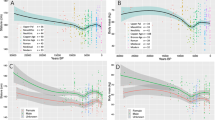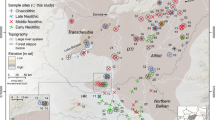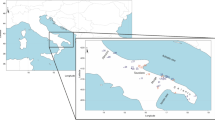Abstract
The introduction of domesticated plants and animals into Britain during the Neolithic cultural period between 5,200 and 4,500 years ago is viewed either as a rapid event1 or as a gradual process that lasted for more than a millennium2. Here we measure stable carbon isotopes present in bone to investigate the dietary habits of Britons over the Neolithic period and the preceding 3,800 years (the Mesolithic period). We find that there was a rapid and complete change from a marine- to a terrestrial-based diet among both coastal and inland dwellers at the onset of the Neolithic period, which coincided with the first appearance of domesticates. As well as arguing against a slow, gradual adoption of agriculture and animal husbandry by Mesolithic societies, our results indicate that the attraction of the new farming lifestyle must have been strong enough to persuade even coastal dwellers to abandon their successful fishing practices.
This is a preview of subscription content, access via your institution
Access options
Subscribe to this journal
Receive 51 print issues and online access
$199.00 per year
only $3.90 per issue
Buy this article
- Purchase on SpringerLink
- Instant access to full article PDF
Prices may be subject to local taxes which are calculated during checkout

Similar content being viewed by others
References
Childe, V. G. Man Makes Himself (Watts, London, 1936).
Dennell, R. W. European Economic Prehistory (Academic, London, 1983).
Schwarcz, H. & Schoeninger, M. Yb. Phys. Anthropol. 34, 283–321 (1991).
Schoeninger, M., DeNiro, M. & Tauber, H. Science 220, 1381–1383 (1983).
Mellars, P. A. Excavations on Oronsay (Edinburgh Univ. Press, Edinburgh, 1987).
Schulting, R. J. & Richards, M. P. Eur. J. Archaeol. 5, 147–189 (2002).
Richards, M. P. & Hedges, R. E. M. Antiquity 73, 891–897 (1999).
Schulting, R. J. & Richards, M. P. Antiquity 76, 1011–1025 (2002).
Tauber, H. Nature 292, 332–333 (1981).
Richards, M. P., Price, T. D. & Koch, E. Curr. Anthropol. 44, 288–294 (2003).
Author information
Authors and Affiliations
Corresponding author
Ethics declarations
Competing interests
The authors declare no competing financial interests.
Additional information
brief communications is intended to provide a forum for brief, topical reports of general scientific interest and for technical discussion of recently published material of particular interest to non-specialist readers (communications arising). Priority will be given to contributions that have fewer than 500 words, 10 references and only one figure. Detailed guidelines are available on Nature's website (http://www.nature.com/nature).
Rights and permissions
About this article
Cite this article
Richards, M., Schulting, R. & Hedges, R. Sharp shift in diet at onset of Neolithic. Nature 425, 366 (2003). https://doi.org/10.1038/425366a
Issue date:
DOI: https://doi.org/10.1038/425366a
This article is cited by
-
Multiproxy bioarchaeological data reveals interplay between growth, diet and population dynamics across the transition to farming in the central Mediterranean
Scientific Reports (2023)
-
Human consumption of seaweed and freshwater aquatic plants in ancient Europe
Nature Communications (2023)
-
A multi-isotope analysis on human and pig tooth enamel from prehistoric Sichuan, China, and its archaeological implications
Archaeological and Anthropological Sciences (2022)
-
Marine resource abundance drove pre-agricultural population increase in Stone Age Scandinavia
Nature Communications (2020)
-
Continuation of fishing subsistence in the Ukrainian Neolithic: diet isotope studies at Yasinovatka, Dnieper Rapids
Archaeological and Anthropological Sciences (2020)



